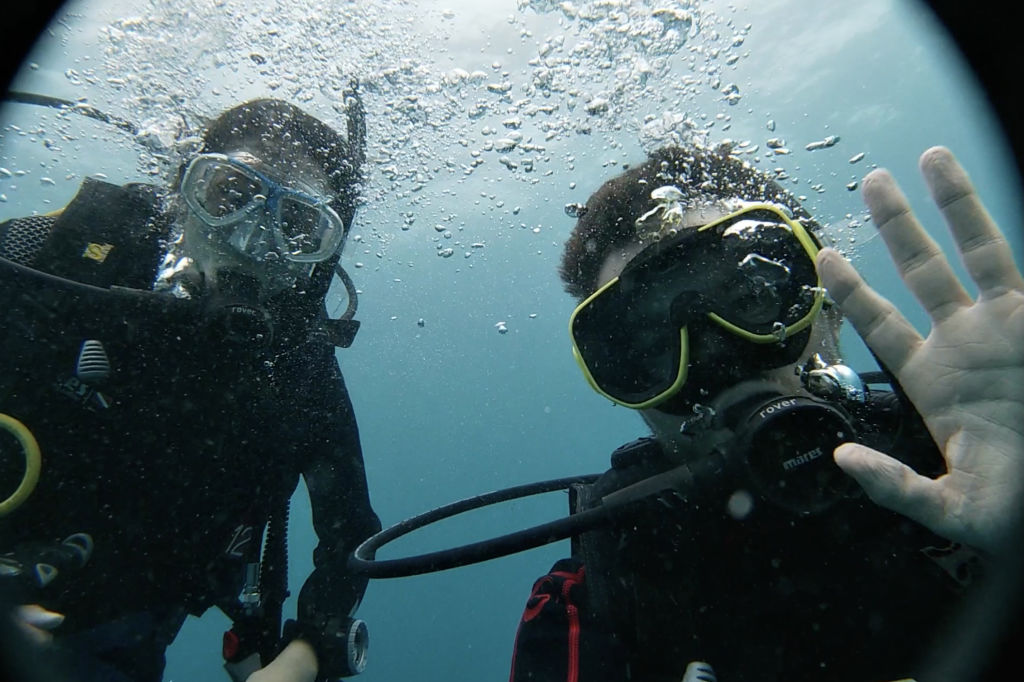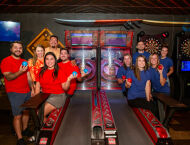Play
 From L to R: Lani Furbank and Zach Barnes. Photo courtesy of subjects.
From L to R: Lani Furbank and Zach Barnes. Photo courtesy of subjects.
Taking the Plunge: Scuba Diving 101
April 29, 2022 @ 9:00am
This summer offers a renewed possibility for travel. There’s a collective desire to seize opportunities for adventure, like scuba diving. Exploring the world below the water’s surface is on many people’s bucket lists. However, the equipment, risks and certification process are barriers. With the help of a local couple who recently underwent scuba diving certification, we’ve created a comprehensive beginner’s guide for people who want to take the plunge. In conjunction with this article, we also interviewed an expert diver and paleontologist who explores intense waters for fossils. Read that article here.
Testing the Waters
Spring 2021, local writer Lani Furbank, her husband Zach Barnes and Furbank’s parents traveled to Costa Rica to get their diving certifications. After seeing friends’ underwater photos and hearing their scuba stories, Furbank was inspired.
“[Learning to scuba dive], traveling and going underwater felt like unlocking a new level of life,” Furbank says.
Barnes agrees with her sentiments. Since he was a teenager, he wished to learn to dive but was apprehensive since his ears had trouble equalizing pressure underwater. Before committing to the trip, they decided to test things out.
“We took a discover scuba course at Aquatic Adventures in Springfield, Virginia,” Furbank says, who also noted her parents tagged along. “It wasn’t an [actual certification] but a bonus pre-course. It helped us get comfortable with the equipment and all the different intricacies of what you [need] to get certified.”
After a successful practice run, they set their sights on completing the certification.
Let’s Get Certified
To earn a Professional Association of Diving Instructors (PADI) certification, there are three components: an academic course, pool training and open water training. The academic portion offers both online or in-person classes, takes approximately 15 hours to complete at one’s own pace and includes reading materials and exams.
The academic component needs to be completed before stepping into the water.
“The biggest thing I got freaked out by was the online course,” Furbank recalls. “[PADI] wants to let you know of all the things that could happen to you, so the course is all of the risks and worst-case scenarios which is honestly quite terrifying.”
After completing the academic course, the training processes can vary depending on dive company. For Furbank and Barnes, training included four pool dives and four ocean dives over the span of four days. There was roughly one instructor for every group of three to five people in their program.
If you are looking to get certified, it can be helpful to complete the training with a friend.
“You have a buddy anyway [when diving] as is policy,” Barnes says. “And part of the training is pulling the regulator from your mouth [which controls your air supply to the oxygen tank] at the bottom and breathing from the other person’s regulator. So, it’s probably a little easier to do that with someone you are comfortable with.”
Other training components include an endurance test where you’re asked to swim 60 to 100 yards in the open water without a mask or flotation device. Overall, though, people of different abilities should not feel deterred to scuba dive.
“The instructors talked to us about people who have a variety of physical differences and can still dive,” Barnes says.
The Case for Abroad
When choosing where to get diving certified, the possibilities are endless. There are places throughout the DMV that offer certifications, but Furbank and Barnes opted for Costa Rica, which was less expensive than the U.S. The total cost for certification can fluctuate between $350 to $500 due to no standard price on training components.
As Furbank notes, “Part of the reason we went overseas was even with the plane ticket and the certification, we paid [less than we would] for certification in the States.”
Barnes also adds the rental cost of all the equipment and gear should be included in the certification program, and if not, you should probably go somewhere else.
Suit Up
Basic scuba gear and equipment required for divers include a regulator, oxygen tank, buoyancy control device (BCD), weights, an oxygen reader, mask, fins and a wetsuit.
BCD and weights are important because you need to be at a level to float effortlessly. The goal is to expend as little energy as possible underwater so you don’t use the oxygen tank too quickly. BCD is a vest that adjusts your weight to achieve an optimum balance while you are underwater. At surface level, the BCD can serve as a life vest.
When suiting up, it is important to prepare yourself for the weight of the equipment.
“The tanks are the heaviest part and most people will need help getting it onto their backs,” Furbank says. “The dive crew will suit you up on the side of the boat and then tip you into the water. It’s a bit nerve-wracking for the first time, getting plunged into the water with a huge thing on your back.”
Conserving Energy
When it comes to scuba diving, conserving energy is the name of the game. With the assistance of a BCD you also want to physically exert as little energy as possible when you’re swimming. You don’t need to be a fast swimmer underwater to be successful at scuba diving, but rather a controlled and slow swimmer.
“One of our friends [who dives] is a very strong athlete,” Barnes says. “He usually runs out of his oxygen first because he’s zooming around wanting to see everything.”
What’s On the Horizon
On their first trip out to an open water dive, a storm had just passed. Despite natural nerves for their first dive, Furbank and Barnes were surprised by the experience.
“The waters were intense from the storm,” Barnes notes, “but once we got underwater it was instantly calm. It was weird because being underwater was a huge relief.”
Guided by ropes attached to barrels anchored to the bottom of the floor 58 feet deep as they descended, Furbank and Barnes were welcomed by sea turtles, eels and fish all the colors of the rainbow. They spent 45 minutes underwater with one-stop 10 feet below the surface — out of precaution for the bends — before ascending back to top.
Furbank and Barnes both described the experience as transformative and are eager to plan their second diving trip — hopefully to Cozumel, Mexico.
DMV Dive Shops + Communities
Atlantic Edge Scuba: 7672 Airpark Rd. Gaithersburg, MD;
atlanticedge.com // @atlanticedgescuba
Aquatic Adventures Scuba Academy: 5408-C Port Royal Rd. Springfield, VA;
aquaticadventuresva.com // @learn2diveva
Blue Octopus Scuba: 4154 Duke St. Alexandria, VA;
blueoctopusscuba.com // @blue_octopus_scuba
Blue Planet Scuba: 1755 S St. NW, DC;
blueplanetdc.com // @blueplanetdc
National Association of Black Scuba Divers: nabsdivers.org // @officialnabsdivers
National Diving Center: 4932 Wisconsin Ave. NW, DC;
dcsurfaceinterval.com // @nationaldivingcenter
SCUBA Professional Education Dive School: 4601 North Park Ave. #C-13 Chevy Chase, MD; scubaedu.com // @spediveschool
Underwater Adventure Seekers*: uasdivers.org
*Editor’s note: Underwater Adventure Seekers is a dive club for recreational and scientific divers and is part of the National Association of Black Scuba Divers. Founded in 1958, they are the oldest Black scuba diving club in the world.







